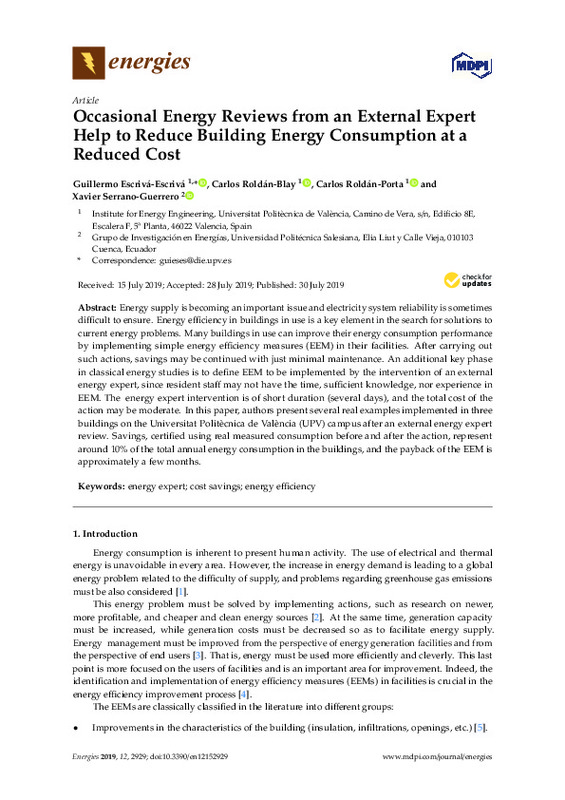JavaScript is disabled for your browser. Some features of this site may not work without it.
Buscar en RiuNet
Listar
Mi cuenta
Estadísticas
Ayuda RiuNet
Admin. UPV
Occasional Energy Reviews from an External Expert Help to Reduce Building Energy Consumption at a Reduced Cost
Mostrar el registro sencillo del ítem
Ficheros en el ítem
| dc.contributor.author | Escrivá-Escrivá, Guillermo
|
es_ES |
| dc.contributor.author | Roldán-Blay, Carlos
|
es_ES |
| dc.contributor.author | Carlos Roldán-Porta
|
es_ES |
| dc.contributor.author | Serrano-Guerrero, Johnny Xavier
|
es_ES |
| dc.date.accessioned | 2020-04-08T05:58:48Z | |
| dc.date.available | 2020-04-08T05:58:48Z | |
| dc.date.issued | 2019-08-01 | es_ES |
| dc.identifier.uri | http://hdl.handle.net/10251/140502 | |
| dc.description.abstract | [EN] Energy supply is becoming an important issue and electricity system reliability is sometimes difficult to ensure. Energy efficiency in buildings in use is a key element in the search for solutions to current energy problems. Many buildings in use can improve their energy consumption performance by implementing simple energy efficiency measures (EEM) in their facilities. After carrying out such actions, savings may be continued with just minimal maintenance. An additional key phase in classical energy studies is to define EEM to be implemented by the intervention of an external energy expert, since resident staff may not have the time, sufficient knowledge, nor experience in EEM. The energy expert intervention is of short duration (several days), and the total cost of the action may be moderate. In this paper, authors present several real examples implemented in three buildings on the Universitat Politecnica de Valencia (UPV) campus after an external energy expert review. Savings, certified using real measured consumption before and after the action, represent around 10% of the total annual energy consumption in the buildings, and the payback of the EEM is approximately a few months. | es_ES |
| dc.description.sponsorship | This research work has been made possible with the support of the Programa de Apoyo a la Investigacion y Desarrollo (PAID-06-12) of the Universitat Politecnica de Valencia (Spain) and the GV/2015/068 (support for I+D projects from emerging research groups). | es_ES |
| dc.language | Inglés | es_ES |
| dc.publisher | MDPI AG | es_ES |
| dc.relation.ispartof | Energies | es_ES |
| dc.rights | Reconocimiento (by) | es_ES |
| dc.subject | Energy expert | es_ES |
| dc.subject | Cost savings | es_ES |
| dc.subject | Energy efficiency | es_ES |
| dc.subject.classification | INGENIERIA ELECTRICA | es_ES |
| dc.title | Occasional Energy Reviews from an External Expert Help to Reduce Building Energy Consumption at a Reduced Cost | es_ES |
| dc.type | Artículo | es_ES |
| dc.identifier.doi | 10.3390/en12152929 | es_ES |
| dc.relation.projectID | info:eu-repo/grantAgreement/UPV//PAID-06-12/ | es_ES |
| dc.relation.projectID | info:eu-repo/grantAgreement/GVA//GV%2F2015%2F068/ | es_ES |
| dc.rights.accessRights | Abierto | es_ES |
| dc.contributor.affiliation | Universitat Politècnica de València. Departamento de Ingeniería Eléctrica - Departament d'Enginyeria Elèctrica | es_ES |
| dc.description.bibliographicCitation | Escrivá-Escrivá, G.; Roldán-Blay, C.; Carlos Roldán-Porta; Serrano-Guerrero, JX. (2019). Occasional Energy Reviews from an External Expert Help to Reduce Building Energy Consumption at a Reduced Cost. Energies. 12(15-2929):1-14. https://doi.org/10.3390/en12152929 | es_ES |
| dc.description.accrualMethod | S | es_ES |
| dc.relation.publisherversion | https://doi.org/10.3390/en12152929 | es_ES |
| dc.description.upvformatpinicio | 1 | es_ES |
| dc.description.upvformatpfin | 14 | es_ES |
| dc.type.version | info:eu-repo/semantics/publishedVersion | es_ES |
| dc.description.volume | 12 | es_ES |
| dc.description.issue | 15-2929 | es_ES |
| dc.identifier.eissn | 1996-1073 | es_ES |
| dc.relation.pasarela | S\397048 | es_ES |
| dc.contributor.funder | Generalitat Valenciana | es_ES |
| dc.contributor.funder | Universitat Politècnica de València | es_ES |
| dc.description.references | Zhang, Y., Kang, J., & Jin, H. (2018). A Review of Green Building Development in China from the Perspective of Energy Saving. Energies, 11(2), 334. doi:10.3390/en11020334 | es_ES |
| dc.description.references | Treado, S., & Chen, Y. (2013). Saving Building Energy through Advanced Control Strategies. Energies, 6(9), 4769-4785. doi:10.3390/en6094769 | es_ES |
| dc.description.references | Pérez-Navarro, A., Alfonso, D., Ariza, H. E., Cárcel, J., Correcher, A., Escrivá-Escrivá, G., … Vargas, C. (2016). Experimental verification of hybrid renewable systems as feasible energy sources. Renewable Energy, 86, 384-391. doi:10.1016/j.renene.2015.08.030 | es_ES |
| dc.description.references | Roldán-Blay, C., Escrivá-Escrivá, G., Roldán-Porta, C., & Álvarez-Bel, C. (2017). An optimisation algorithm for distributed energy resources management in micro-scale energy hubs. Energy, 132, 126-135. doi:10.1016/j.energy.2017.05.038 | es_ES |
| dc.description.references | Martinopoulos, G., Kikidou, V., & Bozis, D. (2018). Energy Assessment of Building Physics Principles in Secondary Education Buildings. Energies, 11(11), 2929. doi:10.3390/en11112929 | es_ES |
| dc.description.references | Marchi, B., Zanoni, S., Mazzoldi, L., & Reboldi, R. (2016). Product-service System for Sustainable EAF Transformers: Real Operation Conditions and Maintenance Impacts on the Life-cycle Cost. Procedia CIRP, 47, 72-77. doi:10.1016/j.procir.2016.03.041 | es_ES |
| dc.description.references | Escrivá-Escrivá, G., Santamaria-Orts, O., & Mugarra-Llopis, F. (2012). Continuous assessment of energy efficiency in commercial buildings using energy rating factors. Energy and Buildings, 49, 78-84. doi:10.1016/j.enbuild.2012.01.020 | es_ES |
| dc.description.references | Escrivá-Escrivá, G. (2011). Basic actions to improve energy efficiency in commercial buildings in operation. Energy and Buildings, 43(11), 3106-3111. doi:10.1016/j.enbuild.2011.08.006 | es_ES |
| dc.description.references | Training Program on Sustainable Energy Regulation and Policymaking for Africahttp://www.unido.org/en/what-we-do/environment/energy-access-for-productive-uses/renewable-energy/selected-projects/training-package.html | es_ES |
| dc.description.references | Magrini, A., Gobbi, L., & d’ Ambrosio, F. R. (2016). Energy Audit of Public Buildings: The Energy Consumption of a University with Modern and Historical Buildings. Some Results. Energy Procedia, 101, 169-175. doi:10.1016/j.egypro.2016.11.022 | es_ES |
| dc.description.references | Marrone, P., Gori, P., Asdrubali, F., Evangelisti, L., Calcagnini, L., & Grazieschi, G. (2018). Energy Benchmarking in Educational Buildings through Cluster Analysis of Energy Retrofitting. Energies, 11(3), 649. doi:10.3390/en11030649 | es_ES |
| dc.description.references | Escrivá-Escrivá, G., Segura-Heras, I., & Alcázar-Ortega, M. (2010). Application of an energy management and control system to assess the potential of different control strategies in HVAC systems. Energy and Buildings, 42(11), 2258-2267. doi:10.1016/j.enbuild.2010.07.023 | es_ES |
| dc.subject.ods | 12.- Garantizar las pautas de consumo y de producción sostenibles | es_ES |








